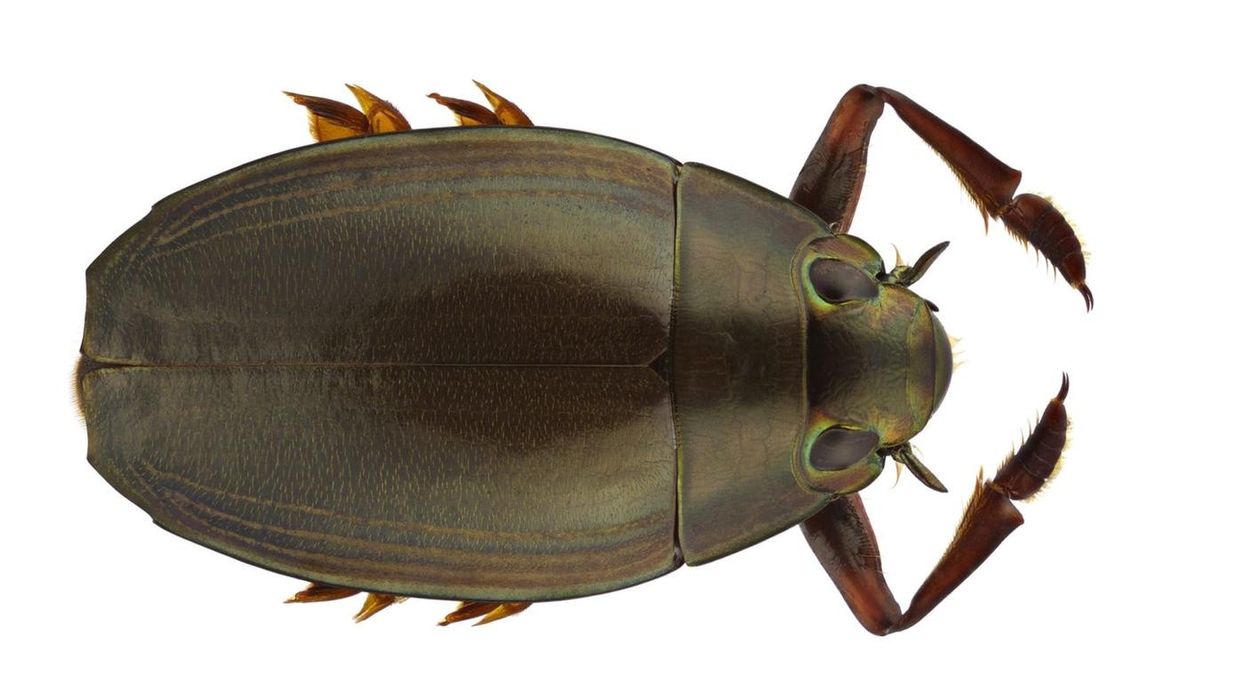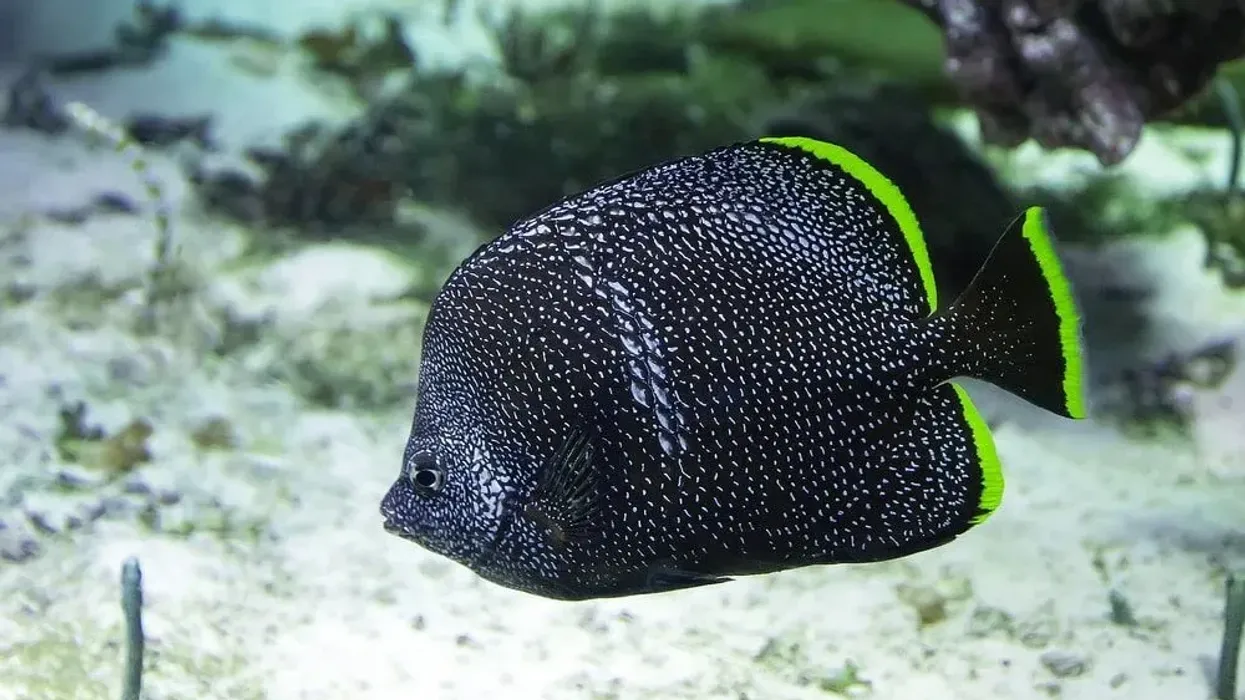Whirligig beetles are small to medium-sized beetles that belong to the family Gyrinidae and order Coleoptera. They are found in water habitats like ponds, streams, and lakes.
They have a flattened body, fringed gills on the abdominal segment, and two sets of eyes that help them to see above the water surface as well as underwater.
They are known to swim rapidly and feed on dead insects that can be found on the water surface. Their middle and hind legs are flattened in shape and short in size which helps them to paddle through the water.
They have three pairs of segmented legs and their front legs are comparatively much longer and help them to grasp their food or prey, which is mainly other smaller insects or invertebrates. Males have a special feature known as suckers on their legs, which helps them to grab the slippery body of females tightly while mating.
Adult males and females die soon after eggs are laid by the female on the surface of aquatic plants or vegetation.
They are generally 0.1-0.7 in (3-18 mm) long. In the face of approaching danger, some individuals will also leave the water and fly to avoid getting attacked by their predators.
If you are fascinated by the whirligig beetle, then you may want to read the following amazing facts about them. If you want to learn more about different animals, you can read up on the ghost moth and the Asian lady beetle.
Whirligig Beetle Interesting Facts
What type of animal is a whirligig beetle?
The whirligig beetles are species of beetle that can be found in water habitats like rivers, streams, lakes, and ponds. They belong to the order Coleoptera and the family Gyrinidae.
What class of animal does a whirligig beetle belong to?
The whirligig beetle belongs to the Insecta class and the order Coleoptera.
How many whirligig beetles are there in the world?
The exact population of these species of beetles is not yet known. However, they are far from extinction and can be found in large numbers throughout the world.
Their habitat includes aquatic regions like lakes, rivers, and ponds. There are around 15 genera and 700 known species of the whirligig beetle including the Dineutus americanus, the Dineutus angustus, and others.
Where does a whirligig beetle live?
The whirligig beetle inhabits aquatic habitats like ponds, streams, rivers, and lakes. Mostly, they can be seen swimming on the surface of the water, but when there is an approaching threat nearby, they tend to dive into the water and float underwater. They can be found all over the world.
What is a whirligig beetle's habitat?
There is a range of water habitats where this species of beetle can be found. Large numbers of the whirligig beetle can be found in abundance, worldwide, in water habitats like ponds and rivers.
Who do whirligig beetles live with?
The whirligig beetles move in groups, especially in summer, consisting of hundreds of individuals. They can be seen swimming on the surface of the water together or feeding on the remains of the other insects that can be found floating on the surface of the water.
How long does a whirligig beetle live?
The average lifespan of a whirligig beetle is a year and depends upon when they mate. Males and females are known to die soon after the female whirligig beetles have laid their eggs.
How do they reproduce?
The life cycle of a whirligig beetle has four stages, egg, larva stage, pupal stage, and adult stage. Females lay around 20-50 eggs.
Eggs are laid in a row under the water, usually on vegetation.
The incubation period lasts for up to 17 days, following which, the hatching of the larva occurs in late summer and they start feeding.
At the end of the larvae stage, they leave the water and form a pupal case or a cocoon attached to the underwater plants or vegetation, and finally, an adult whirligig beetle emerges from the pupal case located on plants, after the completion of this stage, which lasts for up to 10 days.
Adults are known to die immediately after the eggs are laid by the females.
What is their conservation status?
The conservation status of this species of beetles is not listed. They can be found in abundance in and around water habitats and are an important part of the ecosystem. Their ability to swim fast helps them to evade predators. Currently, there are around 700 known species of the whirligig beetle in the world.
Whirligig Beetle Fun Facts
What do whirligig beetles look like?

The whirligigs are small to medium-sized in shape and the outer layer of their bodies is hard and flattened and is covered with little pits. The smooth layer of their body makes it difficult for one to catch hold of them, as they tend to slip from one's hands.
They are mostly bronze or gray in color, which makes them almost invisible or hard to notice from a long distance.
They have two pairs of compound eyes that are divided, which enable them to see both above the water and below the water as well. They have three pairs of segmented legs and their front legs are relatively longer than their middle and hind legs to help them grasp their food or prey.
They have fringed gills on the abdominal segment.
They have well-developed wings that help them to evade their predators in the face of danger. Adult males have a special feature attached to their legs, known as suckers, that help them to grab the slippery body of their female, while mating.
How cute are they?
Whirligig beetles are not at all cute. Like most other insects, they are ugly to look at. When encountering one, the most natural reaction would be to evade it rather than trying to pet it.
How do they communicate?
Beetles, in general, are known to communicate with each other with the help of chemical signals. The whirligig beetles use their antennae to detect any prey nearby or any approaching threat. Their antennas help them to notice any slight movement in the water. They're also thought to use their unique swimming motions to communicate with each other.
How big is a whirligig beetle?
The whirligigs are small to medium in length and their size varies from individual to individual. The average size of a whirligig beetles ranges from 0.1-0.7 in (3-18 mm) in length. They are smaller in size than the Actaeon beetles, which are considered to be the heaviest beetle in the world.
How fast can a whirligig beetle fly?
The exact flying speed of this species is not yet known. They can mostly be found on the surface of the water.
However, in the face of threat or for mating purposes, they can use their well-developed wings to their advantage. They are also good swimmers and can swim fast to catch hold of their prey and to evade their predators.
How much does a whirligig beetle weigh?
The exact weight of this species of water beetle is not yet known.
What are their male and female names of the species?
There is no gender-specific name for the whirligigs. Male whirligig beetles are called males and female whirligig beetles are called females.
What would you call a baby whirligig beetle?
There is no specific name for a baby whirligig beetle. They have different stages in their life cycle. They are egg, larva, and pupal, which they go through before finally reaching adulthood.
What do they eat?
Found in water habitats like ponds and rivers, this species is generally carnivorous by nature, feeding on aquatic insects and other invertebrates. They mainly feed on the insects that fall into the water.
Very frequently, they can also be seen feeding on dead aquatic insects as well. They can swim fast to catch hold of their aquatic prey and to evade their predators.
Are they poisonous?
Like most other species of beetles, these beetles, too, are not at all dangerous. They do not bite humans in general. When encountered by a human, a whirligig beetle is most likely to flee, instead of attacking the person standing in front of it.
Would they make a good pet?
No, the whirligigs do not make a good pet. They are very hard to catch, because of the slippery outer layer of their body.
They are not dangerous and do not bite humans. However, they should not be kept as a pet. The best possible way to care for them is to let them be in the wild the way they are.
Did you know...
Whirligigs display a very unique behavior when they form groups. Hungry beetles can be seen in the outer ring of the group because competition for food is relatively low in that area.
However, it also brings them closer to the chance of getting attacked by a predator. Males, in general, are known to be present on the outer sides of the group.
The whirligigs get their name from their very unique tendency to move rapidly in circles collectively, or alone, when they feel threatened by an approaching threat or predator.
Beetle is a decomposer because they feed on the bodies of dead insects and in turn, convert them into nutrients that are absorbed into the ground.
Although most of the species of water beetles can only be found in water habitats, there are a few known species of water beetles that are native to the land.
Do whirligig beetles bite?
No, the whirligig beetles do not bite at all. Bites from beetles are rare, and even if they do bite, they do not cause any life-threatening injuries to human beings.
Whirligig beetles do not display any form of aggressive behavior towards humans. The docile nature of this species of bugs often tempts humans to keep them as a pet. They are however very hard to catch and will slip away from one's fingers when one tries to catch hold of them.
How many eyes does a whirligig beetle have?
The whirligig beetles have two pairs of compound eyes that are divided, commonly known as the aerial eyes and the sub-aquatic eyes. As the name suggests, the upper pair, or the aerial eyes, help them to see above the water surface.
The lower pair of eyes, or the sub-aquatic eyes, help them to see below the surface of the water or underwater.
Apart from their functions, another difference between the two pairs of eyes possessed by these beetles, is that their upper eyes are covered with nanostructures that help them to detect the wavelength of light. This feature is not present in their lower pair of eyes.
Here at Kidadl, we have carefully created lots of interesting family-friendly animal facts for everyone to discover! Learn more about some other arthropods including Oriental cockroach facts and dung beetle facts.
You can even occupy yourself at home by coloring in one of our free printable whirligig beetle coloring pages.










